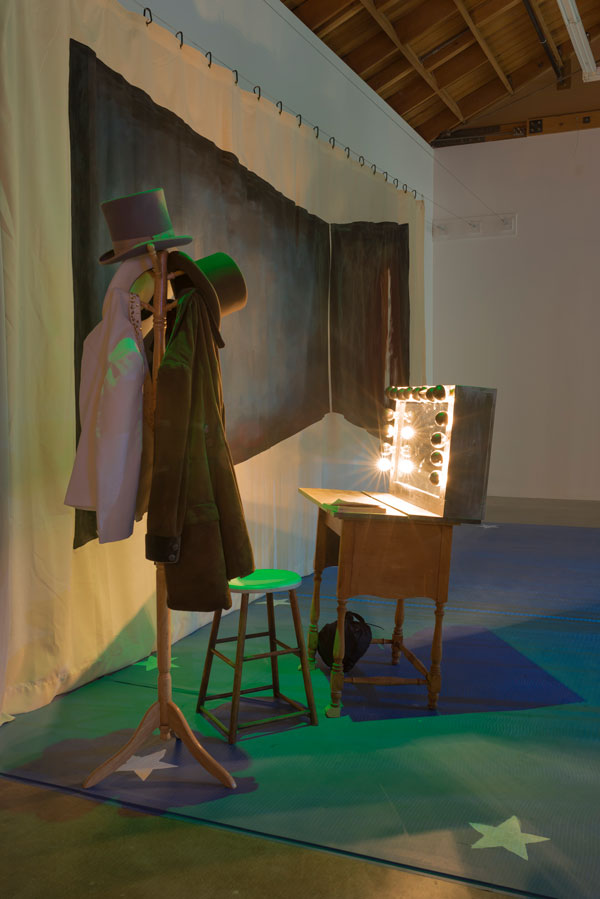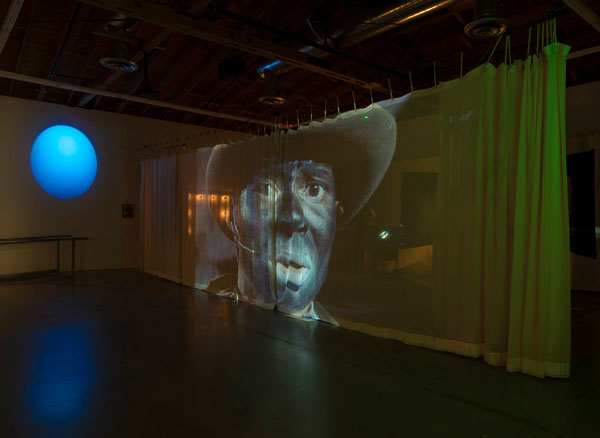There are a number of emotional responses to walking through a graveyard: firstly, satisfaction that one is walking at all and not an insensate resident; another, for those seduced by death and rejected by the quick, is the camaraderie of obliging, complementary silence.
A third response, unrelentingly stealthy, is that ghosts are real; sewn to our heels like shadows, unshakeable and whispering. Such is the condition of the African American, false heir to the nation’s patrimony, willing patsy in a cultural three-card-monte, fully knowing the game is rigged yet ever certain of an eventual win. This double consciousness is on full display in Edgar Arceneaux’s exhibition “Until, Until, Until….” The short play (2015)—it gives the exhibition its name and is amplified with large-scale drawings and sculptural objects—is reimagined as a video installation. It explores the generational burden of vacant hope by reviving the long dead vaudevillian Bert Williams, as played by Broadway star Ben Vereen, as interpreted by singer/songwriter Frank Lawson.
Arceneaux restages the performance given by Vereen for the Reagan inaugural but includes the truncated coda (edited and excised like much of black history), a rejoinder of defiance, uplift and pathos against the preceding minstrelsy. His redemptive strategy upended, Vereen seemed to further hallmark the degradative association; Arceneaux amends the record. Projected on a scrim, viewable from both sides and accompanied by backstage theatrical props, it is an enveloping and affecting experience.

Edgar Arceneaux, “Until, Until, Until…,” Susanne Vielmetter Los Angeles Projects, installation view, courtesy of the artist and Susanne Vielmetter Los Angeles Projects, photo by Robert Wedemeyer
A second gallery furthers the conflicted racial narrative with a disturbing collection of found-object sculptures. A chest-high crenelation of seven glass-covered pedestals contain a series of legal tomes from 1896—the year the U.S. Supreme Court upheld segregation as the law of the land with its Plessy v. Ferguson decision. Each book rests on a mirror and is slightly fanned open, but the pages and covers are encrusted, halfway deep toward the spine, with a thick and prickly layer of sugar crystals. The canny use of sugar deepens the narrative of historical subjection and references the previous gallery—Bert Williams was a native of the Bahamas, and sugar was a principal component that drove the slave trade in the Caribbean and circum-Caribbean nations. The slave trade consequently drove miscegenation and the resulting pigmentocracy that preferred the light-skinned mulatto. This was not, however, enough of a privilege for Williams whose light complexion was a near miss; his disqualifying negritude required him to wear blackface, lest there be any confusion. These works deftly remind us of Adrian Piper’s seminal 1988 work, Cornered.
Zora Neale Hurston’s 1942 short, Story in Harlem Slang, includes a glossary. Under the entry “Color Scale,” she lists in descending order: high yaller, yaller, high brown, vaseline brown, seal brown, low brown, dark black. Both Bert Williams and the artist himself would occupy the highest category but it didn’t and doesn’t matter. It is the one drop rule (in Australia it is called “the convict taint”). It is a distinction that never dies.
Just look around; in Black America, the graveyard follows you home.



















0 Comments